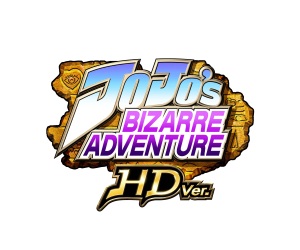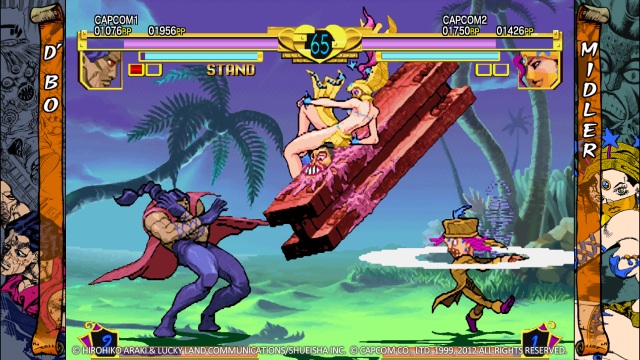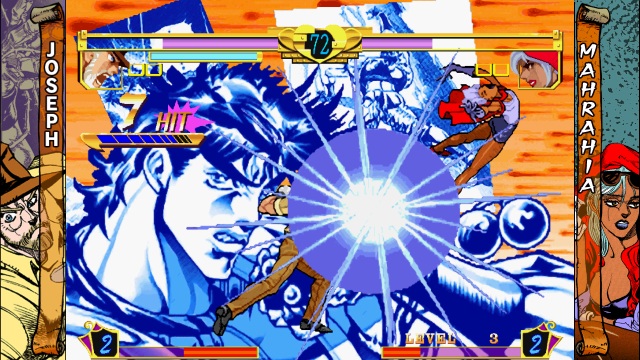JoJo’s Bizarre Adventure Review
 Game: JoJo’s Bizarre Adventure
Game: JoJo’s Bizarre Adventure
Developer: Capcom
Publisher: Capcom
Available on: Xbox 36o, PlayStation 3
Reviewed on: Xbox 360
It staggered me back at the turn of the century, when it was announced that JoJo’s Bizarre Adventure was coming to Europe for the PlayStation and Dreamcast. Here was a niche fighter, released in arcades on Capcom’s powerful CPS-3 hardware, based upon the long-running manga that had barely seen the light of day over here. And what a manga! JoJo is as crackers as they come, a series dating back to the mid Eighties, which has taken in vampirism, Egyptology, necromancy and Terence Trent D’Arby. Yes, you read that right, creator Hirohiko Araki has an obsession with pop and rock artists from the West that borders on the unhealthy, meaning that oodles of the characters in the JoJo-verse are named after musical acts. The “Vibrator” singer isn’t the only example, you have J Geils, Chaka & Khan, Steely Dan and even Vanilla Ice, although the latter was renamed “Iced” for the video game, presumably in fear of Robert Van Winkle lawyering up and suing their crazy ass.
CPS-3 was the last time Capcom made their own arcade boards in-house as it were, and despite the success of the previous CP boards, which had lit up arcades with titles like Ghosts ‘N’ Goblins, Street Fighter II and Progear No Arashii, there were only six games released for it. Unsurprisingly for the time, all six of these were 2D one-on-one fighters, the most famous of which was Street Fighter III: 3rd Strike Fight For The Future, which is still played by millions to this day. The other games were the two previous incarnations of Street Fighter III, the seldom-seen oddity Red Earth, and the two versions of the JoJo fighter that are combined to make up this here release.

What sort of a game is it? Well for starters, it is a far cry from the fast paced, parrying and tech fest that is 3rd Strike, JoJo is more like an Arc System Works title than a Capcom game. There are the usual basic attacks, and of course super moves and all of the things you would expect from a turn of the century brawler. There is a rather unique flavour to JoJo however, which stood out at the time.
With a few exceptions, each character has the ability to enter “Stand” mode. Stand is a concept that was first developed in the third story arc of the original manga. Essentially a physical manifestation of psychic power, Stand can have a number of different effects on each combatant. Some Stand powers may completely alter the physical state of the individual, such as Iggy, who transforms into a larger, more ferocious version of himself, made of sand. Others give special abilities, such as Jonathan’s Hermit Purple (stop sniggering at the back) which allows him to wield crazy purple vines which can grab opponents. Other Stands summon another bod to fight alongside you, that can aid your beatdown of an opponent but also makes you vulnerable, as the other physical entity can take damage as well. The overall effect is a precursor to the celestial beings that are summoned in Arc’s excellent Arcana Heart series, or Carl Clover’s doll from BlazBlue, and for the time was a truly innovative and imaginative addition to the genre.
Playing the game today, it is clear that JoJo is very much a game of its time. The characters are extremely unbalanced, meaning that some are way more powerful than others. Take the Artist Formerly Known As Vanilla Ice (Iced). Regardless of whether you are in Stand mode or not, he has an arsenal of near unblockable moves, including one where he turns himself into a large, circular projectile that can move at terrific speeds. The bonus stages from the original now seem clunky and unnecessary, particularly the mad dash across the desert, where you have to avoid a harmful Water Stand in a horizontally scrolling section that is more frustrating than fun. But there are few games that can make you guffaw with the sheer mental-case bonkers-ness of the plot and cutscenes like this one, and even though it is now getting on for fourteen years old, it still looks absolutely stunning, in the same way that 3rd Strike or Garou Mark of the Wolves can be appreciated for their superlative animation.

VERDICT: As a HD remake, this is an expensive package when you consider what is on offer. There are very limited extras in the package: a few very easy to hoover up Achievements, and a sparsely contested online mode, which is populated mainly by people from Japan who will happily give you a lag-filled kicking. The game is hindered with huge borders on either side of the action, and the excellent Story Mode from the original PS/DC release is non existent.
In terms of HD makeover, there is an option to smooth out the pixellated sprites, but it is a lovely looking game that coasts by on its own graphical charms without the need for your fancy filters. Perhaps the most disappointing thing of all is the price, at 1600 Microsoft Points this is one of the more expensive titles on the Xbox LIVE Arcade, and while it is a nice little slice of fighting history, you would be better off saving your money and picking up one of the newer Arc titles for less.






